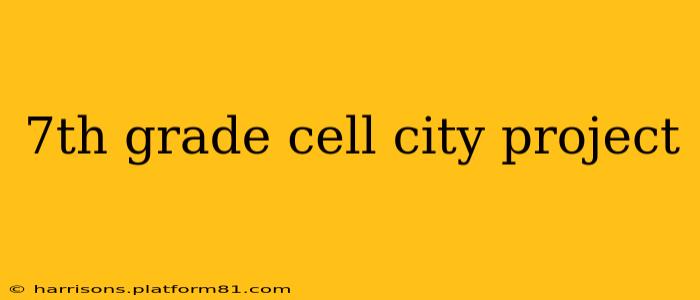The 7th-grade cell city project is a fantastic way to learn about cell biology in a fun, engaging, and memorable way. This project allows students to creatively illustrate the complex inner workings of a cell by comparing it to a bustling city. This guide will walk you through everything you need to know to create a stellar project, from brainstorming ideas to mastering the presentation.
What is a Cell City Project?
The core concept of the cell city project is to create an analogy between the different parts of a cell and the different aspects of a city. Just as a city has various components working together—like buildings, transportation, power plants, and citizens—a cell has numerous organelles, each with a specific function crucial to the cell's survival. Your project will visually represent these components and their interactions.
Choosing Your City's Theme
Before diving into the specifics, consider a fun theme for your cell city. This can make the project more engaging and allow for creative freedom. Here are some ideas:
- Medieval City: Think castles (nucleus), blacksmiths (ribosomes), and bustling marketplaces (cytoplasm).
- Futuristic City: Imagine skyscrapers (endoplasmic reticulum), high-speed transportation (cytoskeleton), and advanced energy sources (mitochondria).
- Fantasy City: Create a magical realm with enchanted forests (chloroplasts - for plant cells), mythical creatures (lysosomes), and a powerful king (nucleus).
The theme you choose will influence how you visually represent each cell organelle.
Key Cell Organelles and Their City Analogies
Here's a breakdown of major cell organelles and how you can represent them in your city:
- Nucleus (City Hall): The control center, containing the city's plans (DNA).
- Cell Membrane (City Walls): Protects the city and controls what enters and exits.
- Cytoplasm (City Streets and Buildings): The bustling environment where everything happens.
- Mitochondria (Power Plants): Generate energy for the city.
- Ribosomes (Factories): Produce proteins (goods) for the city.
- Endoplasmic Reticulum (Roads and Transportation): The network that transports materials throughout the city. The Rough ER could be roads with factories along them, and the Smooth ER could be the smoother, less congested roads.
- Golgi Apparatus (Post Office): Processes and packages materials for transport.
- Lysosomes (Recycling Centers/Waste Management): Break down waste materials.
- Vacuoles (Storage Facilities): Store materials needed by the city.
- Chloroplasts (Solar Power Plants - Plant Cells Only): Convert sunlight into energy.
- Cell Wall (City's Outer Walls - Plant Cells Only): Provides extra protection and support.
H2: How Do I Create My Cell City Model?
This is where your creativity shines! You can use a variety of materials:
- 3D Models: Build a miniature city using cardboard, clay, LEGOs, or other craft supplies.
- Drawings/Paintings: Create detailed illustrations of your city, highlighting each organelle and its function.
- Digital Presentations: Use software like PowerPoint or Google Slides to create a visually appealing presentation of your city.
H2: What Information Should My Project Include?
Beyond the visual representation, your project should include a clear explanation of each organelle and its function within the cell and its corresponding city analogy. Be sure to clearly label each part of your city and connect it to its cellular counterpart. A well-written explanation is crucial for demonstrating your understanding of cell biology.
H2: How Should I Present My Cell City Project?
A compelling presentation is as vital as the model itself. Clearly describe the chosen city theme, the rationale behind your analogies, and explain the roles of each organelle and its city equivalent. Practice your presentation to ensure a smooth delivery.
H2: What are some common mistakes to avoid?
- Poor labeling: Ensure all components of your city are clearly labeled and linked to their corresponding cell organelles.
- Inaccurate analogies: Make sure your analogies accurately reflect the functions of the organelles.
- Lack of explanation: Thoroughly explain the functions of each organelle and its role in the cell.
- Poor presentation: Practice your presentation to ensure a smooth and clear delivery.
Conclusion
The 7th-grade cell city project is an exciting opportunity to explore the fascinating world of cells. By combining creativity, research, and effective presentation skills, you can create a truly memorable and educational project. Remember to plan ahead, utilize diverse resources, and embrace your creativity to make your Cell City stand out!
